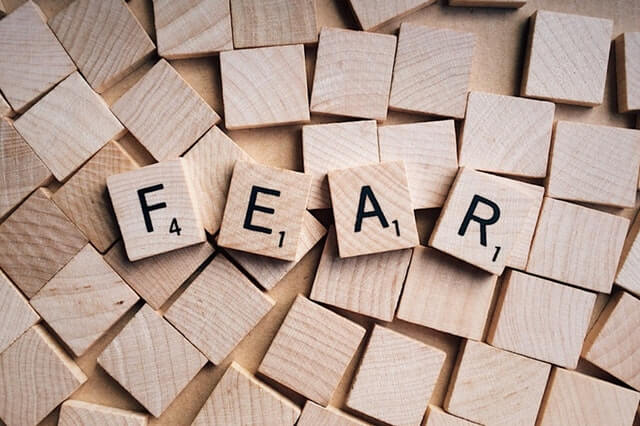List of Phobias A to Z: Some of the Most Common Phobias
Everyone has fears, but when these fears become so overwhelming that they interfere with normal functioning they become known as phobias. It can be helpful to look at a list of phobias to get a better appreciation for the enormous variety of objects and situations that can become a source of anxiety and fear. The…

Everyone has fears, but when these fears become so overwhelming that they interfere with normal functioning they become known as phobias. It can be helpful to look at a list of phobias to get a better appreciation for the enormous variety of objects and situations that can become a source of anxiety and fear.
The following list of phobias explores some of the most common phobias from A to Z.
What Is a Phobia?
A specific phobia is defined in the DSM-5 as an intense fear or anxiety in response to a specific object or situation. Such fears can lead to avoidance, create distress, and interfere with a person’s ability to function in their everyday life.
Phobias are quite common. The National Institute of Mental Health states that 12.5% of U.S. adults experience at least one type of phobia during their lifetime. Phobias are a type of anxiety disorder. Anxiety disorders are one of the most common forms of mental illness.
The American Psychiatric Association reports that phobias are the single most common psychiatric condition among women and the second most common in men 25 and older in the United States.
Types of Phobias
There is an incredible variety in the source of people’s phobias. Because people can become afraid of almost anything, the list of phobias could be extremely long if you attempted to list every possible fear object. Rather than attempt to identify every single possible phobia, experts tend to focus on those that are the most common.
Because phobias can relate to so many different things, the words identifying each phobia are often coined as cases come up. Names are usually formed by taking a Greek word related to the phobic object as the prefix and attaching the suffix -phobia to the end. Although in some cases Latin, English, or partial English-word prefixes are used.
The DSM-5 suggests that phobic objects and situations tend to fall into one of three major categories: agoraphobia, social phobias, and specific phobias. When people search for a ‘list of phobias,’ it is the plethora of individual specific phobias that they are usually interested in.
There are also different subtypes of specific phobias. These specific phobias tend to be in one of five different categories:
- Fears related to the natural world (disasters, storms, weather)
- Fears related to animals (snakes, dogs, bugs)
- Fears related to injury, blood, or medical problems (broken bones, injections)
- Fears related to situations (small spaces, driving, bridges)
- Other fears (loud noises, getting sick, choking)
While creating an exhaustive list of each and every phobia simply is not possible, you can get a clearer picture of the types of fears by looking at a list of some of the more common ones that have been identified.
The Most Common Phobias
According to one survey published in the British Journal of Psychiatry, ten of the most commonly reported phobias were:
- Acrophobia: The fear of heights
- Aerophobia: The fear of flying
- Arachnophobia: The fear of spiders
- Astraphobia: The fear of lightning and thunder
- Autophobia: The fear of being alone
- Claustrophobia: The fear of confined or crowded spaces
- Hemophobia: The fear of blood
- Hydrophobia: The fear of water
- Ophidiophobia: The fear of snakes
- Zoophobia: The fear of animals
Some other fairly common phobias include mysophobia (the fear of germs), trypanophobia (the fear of injections), and necrophobia (the fear of death).
List of Rare Phobias
As you looked through the list of phobias above, you might find that you have experienced one of these common fears – or you can at least sympathize with people who do. However, not all fears are quite so common.
Some rare phobias include:
- Anthrophobia: The fear of flowers
- Arithmophobia: The fear of numbers
- Barophobia: The fear of gravity
- Chronomentrophobia: The fear of clocks
- Genuphobia: The fear of knees
- Hexakosioihexekontahexaphobia: Fear of the number 666
- Hippopotomonstrosesquippedaliophobia: Fear of long words
- Onomatophobia: The fear of names
- Phobophobia: The fear of phobias
- Nephophobia: The fear of clouds
List of Phobias A to Z
A
- Achluophobia: Fear of darkness
- Acousticophobiaz: Fear of noise
- Acrophobia: Fear of heights
- Aerophobia: Fear of aircraft or flying
- Agoraphobia: Fear of open places
- Agyrophobia: Fear of crossing streets
- Aichmophobia: Fear of sharp or pointed objects
- Ailurophobia: Fear of cats
- Algophobia: Fear of pain
- Amaxophobia: Fear of riding in a car
- Ancraophobia: Fear of wind or drafts
- Androphobia: Fear of adult men
- Anginophobia: Fear of angina or choking
- Anthophobia: Fear of flowers
- Anthropophobia: Fear of people or the company of people
- Aphenphosmphobia: Fear of being touched
- Aquaphobia: Fear of water.
- Arachnophobia: Fear of spiders
- Arithmophobia: Fear of numbers
- Astraphobia: Fear of thunder and lightning
- Ataxophobia: Fear of disorder or untidiness
- Atelophobia: Fear of imperfection
- Autophobia: Fear of isolation
B
- Bacteriophobia: Fear of bacteria
- Barophobia: Fear of gravity
- Bathmophobia: Fear of stairs
- Batrachophobia: Fear of amphibians
- Belonephobia: Fear of needles or pins
- Bibliophobia: Fear of books
- Botanophobia: Fear of plans
C
- Cacophobia: Fear of ugliness
- Catagelophobia: Fear of being ridiculed
- Catoptrophobia: Fear of mirrors
- Carcinophobia: Fear of cancer
- Chemophobia: Fear of chemicals
- Cherophobia: Fear of happiness
- Chionophobia: Fear of snow
- Chiroptophobia: Fear of bats
- Chromophobia, chromatophobia: Fear of colors
- Chronomentrophobia: Fear of clocks
- Chronophobia: Fear of time and time moving forward
- Cibophobia, sitophobia: Fear of food
- Claustrophobia: Fear of being trapped with no escape
- Coimetrophobia: Fear of cemeteries
- Colorphobia: Chromophobia
- Coprophobia: Fear of feces or defecation
- Coulrophobia: Fear of clowns
- Cyberphobia: Fear of computers, the Internet, and new technologies
- Cynophobia: Fear of dogs
D
- Decidophobia: Fear of making decisions
- Defecaloesiophobia: Fear of painful bowel movements
- Dementophobia: Fear of insanity
- Demonophobia, daemonophobia: Fear of demons
- Dendrophobia: Fear of trees
- Dentophobia: Fear of dentists and dental procedures
- Diabetophobia: Fear of diabetes
- Dipsophobia: Fear of drinking
- Domatophobia: Fear of houses
- Dromophobia: Fear of crossing streets
- Dysmorphophobia: Fear of physical defects (either real or imagined)
- Dystychiphobia: Fear of accidents
E
- Ecclesiophobia: Fear of church
- Ecophobia: Fear of the home
- Electrophobia: Fear of electricity
- Elurophobia: Fear of cats
- Eisoptrophobia: Fear of mirrors or seeing one’s reflection in a mirror
- Eurotophobia: Fear of female genitals
- Emetophobia: Fear of vomiting
- Enochlophobia: Fear of crowds
- Entomophobia: Fear of insects
- Ephebiphobia: Fear of youth
- Epistaxiophobia: Fear of nosebleeds
- Equinophobia: Fear of horses
- Ergophobia, ergasiophobia: Fear of work or functioning
- Erotophobia: Fear of sexual love or sexual abuse
- Erythrophobia, erytophobia, ereuthophobia: Fear of the color red, or fear of blushing
- Euphobia: Fear of hearing good news
F
- Febriphobia: Fear of fevers
- Francophobia: Fear of France or French culture
- Frigophobia: Fear of becoming too cold
G
- Gamophobia: Fear of commitment, including cohabitation, marriage or nuptials
- Geliophobia: Fear of laughter
- Gelotophobia: Fear of being laughed at
- Geniophobia: Fear of chins
- Gephyrophobia: Fear of bridges
- Genophobia: Fear of sexual intercourse
- Genuphobia: Fear of knees or the act of kneeling
- Gerascophobia: Fear of growing old or aging
- Gerontophobia: Fear of growing old, or a hatred or fear of the elderly
- Globophobia: Fear of balloons
- Glossophobia: Fear of speaking in public or of trying to speak
- Gnosiophobia: Fear of knowledge
- Gymnophobia: Fear of nudity
- Gynophobia: Fear of women
H
- Hadephobia: Fear of hell
- Halitophobia: Fear of bad breath
- Haphephobia: Fear of being touched
- Hedonophobia: Fear of obtaining pleasure
- Heliophobia: Fear of the sun or sunlight
- Hemophobia: Fear of blood
- Herpetophobia: Fear of reptiles
- Hexakosioihexekontahexaphobia: Fear of the number 666
- Hippopotomonstrosesquippedaliophobia: Fear of long words
- Hodophobia: Fear of travel
- Homichlophobia: Fear of fog
- Hoplophobia: Fear of firearms
- Hydrophobia: Fear of water
- Hylophobia: Fear of forests
- Hypnophobia, somniphobia: Fear of sleep
- Hypochondria: Fear of illness
I
- Iatrophobia: Fear of doctors
- Ichthyophobia: Fear of fish
- Ideophobia: Fear of ideas
- Iophobia: Fear of poison
- Isolophobia: Fear of being alone
K
- Kakorrhaphiophobia: Fear of failure
- Katagelophobia: Fear of ridicule
- Kenophobia: Fear of empty spaces
- Kleptophobia: Fear of stealing
- Kopophobia: Fear of fatigue
- Koinoniphobia: Fear of rooms full of people
- Koumpounophobia: Fear of buttons
- Kynophobia: Fear of rabies
L
- Lachanophobia: Fear of vegetables
- Leukophobia: Fear of the color white
- Lilapsophobia: Fear of tornadoes or hurricanes
- Limnophobia: Fear of lakes
- Linonophobia: Fear of string
- Liticaphobia: Fear of lawsuits
- Lockiophobia: Fear of childbirth
- Logizomechanophobia: Fear of computers
- Logophobia: Fear of words
- Lutraphobia: Fear of otters
- Lygophobia: Fear of darkness
- Lyssophobia: Fear of rabies
M
- Mageirocophobia: Fear of cooking
- Megalophobia: Fear of large things
- Melanophobia: Fear of the color black
- Melissophobia, apiphobia: Fear of bees
- Meteorophobia: Fear of meteors
- Methyphobia: Fear of alcohol
- Microphobia: Fear of small things
- Monophobia: Fear of being alone
- Mottephobia: Fear of moths
- Musophobia: Fear of mice
- Mycophobia: Fear or aversion to mushrooms
- Myrmecophobia: Fear of ants
- Mysophobia: Fear of germs, contamination or dirt
N
- Necrophobia: Fear of death or the dead
- Neophobia: Fear of newness, novelty, change or progress
- Nephophobia: Fear of clouds
- Noctiphobia: Fear of the night
- Nomatophobia: Fear of names
- Nomophobia: Fear of being out of mobile phone contact
- Nosocomephobia: Fear of hospitals
- Nosophobia: Fear of contracting a disease
- Nostophobia, ecophobia: Fear of returning home
- Numerophobia: Fear of numbers
- Nyctophobia: Fear of darkness
O
- Obesophobia: Fear of gaining weight
- Octophobia: Fear of the figure 8
- Oikophobia: Fear of home surroundings and household appliances
- Odontophobia: Fear of dentists or dental procedures
- Ombrophobia: Fear of rain
- Oneirophobia: Fear of dreams
- Ophidiophobia: Fear of snakes
- Ophthalmophobia: Fear of being stared at
- Ornithophobia: Fear of birds
- Osmophobia, olfactophobia: Fear of odors
P
- Panphobia: Fear of everything or the constant fear of an unknown cause
- Papyrophobia: Fear of paper
- Pathophobia: Fear of disease
- Pedophobia: Fear of babies and children
- Phagophobia: Fear of swallowing
- Phallophobia: Fear of erections
- Pharmacophobia: Fear of medications
- Phasmophobia: Fear of ghosts or phantoms
- Philophobia: Fear of love
- Phobophobia: Fear of fear itself or of having a phobia
- Phonophobia: Fear of loud sounds or voices
- Podophobia: Fear of feet
- Pogonophobia: Fear of beards
- Pornophobia: Fear of pornography
- Porphyrophobia: Fear of the color purple
- Pteridophobia: Fear of ferns
- Pteromerhanophobia: Fear of flying
- Pyrophobia: Fear of fire
R
- Radiophobia: Fear of radioactivity or X-rays
- Ranidaphobia: Fear of frogs
- Rhypophobia: Fear of defecation
- Rhytiphobia: Fear of getting wrinkles
- Rupophobia: Fear of dirt
S
- Samhainophobia: Fear of Halloween
- Scolionophobia: Fear of school
- Scopophobia: Fear of being looked at or stared at
- Selenophobia: Fear of the moon
- Sexophobia: Fear of sexual organs or sexual activities
- Siderodromophobia: Fear of trains or railroads
- Siderophobia: Fear of stars
- Sociophobia: Fear of people or social situations
- Somniphobia: Fear of sleep
- Spectrophobia: Fear of mirrors
- Spheksophobia: Fear of wasps
- Stasiphobia: Fear of standing or walking
T
- Tachophobia: Fear of speed
- Taphophobia: Fear of the graves or being buried alive
- Tapinophobia: Fear of being contagious
- Taurophobia: Fear of bulls
- Technophobia: Fear of computers or advanced technology
- Teratophobia: Fear of disfigured people
- Tetraphobia: Fear of the number 4
- Thalassophobia: Fear of the sea, or fear of being in the ocean
- Thanatophobia: Fear of dying
- Thermophobia: Fear of high temperatures
- Tokophobia: Fear of childbirth or pregnancy
- Tomophobia: Fear of invasive medical procedure
- Toxiphobia: Fear of being poisoned
- Tremophobia: Fear of trembling
- Triskaidekaphobia, terdekaphobia: Fear of the number 13
- Tonitrophobia: Fear of thunder
- Trypanophobia, belonephobia, enetophobia: Fear of needles or injections
- Trypophobia: Fear of holes or textures with a pattern of holes
U
- Uranophobia, ouranophobia: Fear of heaven
- Urophobia: Fear of urine or urinating
V
- Vaccinophobia: Fear of vaccination
- Vehophobia: Fear of driving
- Venustraphobia: Fear of beautiful women
- Verminophobia: Fear of germs
- Vestiphobia: Fear of clothing
- Virginitiphobia: Fear of rape
W
- Wiccaphobia: Fear of witches and witchcraft
X, Y, Z
- Xanthophobia: Fear of the color yellow
- Xenophobia: Fear of strangers, foreigners, or aliens
- Xerophobia: Fear of dryness.
- Xyrophobia: Fear of razors.
- Zelophobia: Fear of jealousy
- Zeusophobia: Fear of God or gods
- Zemmiphobia: Fear of the great mole rat.
- Zoophobia: Fear of animals
Symptoms of Phobias
Phobias can feel intense and frightening. They may lead to physical, behavioral, and emotional symptoms that create distress and interfere with a person’s ability to function in important life areas. Common symptoms include:
- Avoidance of the feared object or situation
- Chest pain
- Dizziness
- Increased blood pressure
- Intense fear
- Nausea
- Rapid heartbeat and breathing
- Trembling
- Sense of impending death or doom
- Sweating
Characteristics of Phobias
Some key characteristics of phobias include:
- They are persistent
- They are usually irrational
- They involve excessive, intense fear
- They cause the individual to avoid the object or situation
- They result in considerable distress
- They interrupt the individual’s normal functioning and may cause the person to alter their behavior
The latest update to the diagnostic tool used most often by health professionals in the U.S., the DSM-5, says that the criteria for being diagnosed with a specific phobia involve having anxiety that is out of proportion with the actual threat posed by the fear object for a period of 6 months or longer.
Phobias are thought to be influenced by a number of risk factors, including genetics and experiences. Some people may have a genetic predisposition to anxiety disorders. Traumatic experiences involving the feared object can also play a contributing role.
Dealing With a Phobia
If you are experiencing symptoms of a phobia that are making it difficult to function in your daily life or creating significant distress, it is important to get help. There are a number of effective treatments that can help you overcome your phobia.
Some common treatment approaches:
- Exposure therapy: In this process, you are gradually exposed to what you fear. Throughout this process, you also utilize relaxation strategies such as deep breathing to help keep you calm. Over time and with repeated exposure, your fear will gradually fade. This can include real-world exposure to the feared object or situation (in vivo exposure) or imagined exposure using virtual reality.
- Cognitive-behavioral therapy (CBT): This type of therapy involves changing the underlying negative thought patterns that play a part in causing, worsening, or maintaining your fear.
Phobias can be serious, but there are steps you can take to help address your fears. You might consider talking to a therapist about treatment options, or you might even try an app designed to walk you through self-managed exposure therapy.
Sources:
Becker, E. S., Rinck, M., Türke, V., Kause, P., Goodwin, R., Neumer, S., & Margraf, J. (2007). Epidemiology of specific phobia subtypes: Findings from the Dresden Mental Health Study. European Psychiatry, 22(2), 69–74. https://doi.org/10.1016/j.eurpsy.2006.09.006
Curtis, G., Magee, W. J., Eaton, W. W., Wittchen, H.-U., & Kessler, R. C. (1998). Specific fears and phobias: Epidemiology and classification. British Journal of Psychiatry, 173(3), 212–217. https://doi.org/10.1192/bjp.173.3.212
Eaton, W. W., Bienvenu, O. J., & Miloyan, B. (2018). Specific phobias. The lancet. Psychiatry, 5(8), 678–686. https://doi.org/10.1016/S2215-0366(18)30169-X
Samra, C. K., & Abdijadid, S. (2022). Specific phobia. In StatPearls. StatPearls Publishing. http://www.ncbi.nlm.nih.gov/books/NBK499923/
Specific phobia. (n.d.). National Institute of Mental Health (NIMH). https://www.nimh.nih.gov/health/statistics/specific-phobia





